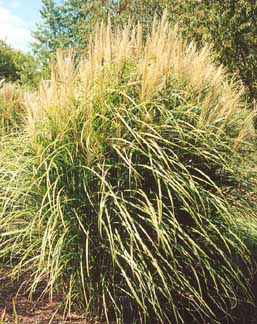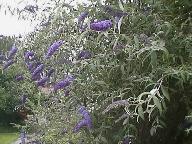Garden Edition: April
by Linda
Coyner
The familiar messengers of spring-cherry
blossoms, dogwoods, forsythia, dandelions, daffodils, greening lawns--signal
the busy season ahead for gardeners. In tropical Florida, the messengers
may be different--the fragrance of citrus heavy in the night air and tabebuia*
in
flower: imagine a tree covered withclusters of forsythia-like blooms --
but the message is just the same. Gardeners busy themselves with
projects ranging from tapping maple trees for syrup to cleaning up lawns
and beds, starting seeds, planting, and weeding. Many of us are already
fretting over what looks to be another dry season.
Beyond
the basic spring clean-up. Besides the basic chores
of leaf raking while gently removing dead stalks and leaves from
last year's perennials and fertilizing, certain plants require special
care. My spring ritual in the Northeast included cutting back butterfly
bushes (Buddleia davidii) and on a cool day, ornamental grasses,
both of which my garden had an abundance. I am a big fan of

perennial grasses, but they can be monsters to cut back. The big
ones are also messy during the year, something the catalogs fail
to mention. Old grass stalks, which, only a few weeks earlier were
an important part of the winter landscape, get raggedy come spring
and can actually impede the new growth. As the larger varieties
fill out, their girth thickens and stalks get tougher to cut.
Powered hedge clippers
do the job lickety-split but don't worry, you'll still get plenty of exercise
picking the cuttings (which, by the way, are great to use as mulch in the
back of the garden). To encourage the tallest growth at the center, cut
the plant shorter at the sides rather than at the center. Before you do
any cutting, though, check for wildlife that may be nesting in the center
of the plant and while at it, place wire cages over those that'll need
support later in the summer. Evergreen grasses like blue fescue (Festuca
glauca) don't need any pruning, unless it's for a haircut when the seed
heads form.
In regions where temperatures
drop below zero,

Buddleia
davidii dies back to the ground. After a mild winter, it may not
be necessary to cut it back at all. One spring I accidentally left
one bush unpruned. Apparently, the winter had been so mild that
the branches hadn't frozen back. It bloomed several weeks ahead
of its pruned garden mates. While you're at it, notice that the
branches of butterfly bushes are arrow straight; save them for staking
perennials later in the summer.
If you're confused about what
to prune back when, just remember it's safe to prune after a plant has
flowered. For instance, now's it safe to prune summer flowering shrubs
such as the rose of sharon, butterfly, etc.; in the summer, prune spring
flowering shrubs such as forsythia, lilac, spirea, etc. It all has
to do with whether the plant blooms on new growth or last year's growth.
Hydrangeas are especially tricky and vary depending on the variety. Not
willing to risk the flowers, I took a very conservative approach to hydrangeas:
I'd wait until the plant had completely leafed out and then cut off the
portion of the branches that were obviously dead along with last year's
flowers.
Assessing
drought and winter damage. It's also a good time
to consider post-drought garden care, and the way it looks for many
areas, pre-drought care. Damage to perennials is readily obvious.
To assess a plant's health, look at its crown for signs of life.
Some plants may need replacing. Trees and shrubs may suffer
the lingering effects of a drought for years to come. On a woody
plant, pruning may be necessary to re-establish a plant's health.
Scratch the bark to see if there's green underneath. If not, scratch
a bit lower on the plant until you see green peeking through. Remove
the portion of the plant above that.
If it turns out you have a lot
of casualties, maybe it's time to consider what you're planting and where
you're planting it. Exotics usually require copious amounts of moisture.
Native plants are better equipped to handle what Mother Nature dishes out.
But even so, some plants are naturally thirstier that others.
Here's a general guideline:
| Astilbe |
Marigold |
| Sweet Pepperbush (Clethra Alnifolia) |
Lamium |
| Yellow Flag (Iris Pseudacorus) |
Sedum |
| Red Twig Dogwood (Cornus Sibirica) |
Purple Cone Flower (Echinacea) |
| Monarda (& other mints) |
Coreopsis |
| Spiderwort (Tradescantia) |
Artemisia |
| Globe Flower (Trollius) |
Rudbeckia |
| Rose Mallow (Hibiscus Moscheutos) |
Flower Carpet Rose |
| Cardinal Flower (Lobelia) |
Rugosa Rose |
| Turtlehead (Chelone Glabra) |
Lavender |
| Joe Pye Weed (Eupatorum) |
Most Floribunda Roses (esp.Betty Prior) |
| Forget-Me-Nots (Myosotis) |
Juniper |
| Impatiens |
Most Ornamental Grasses |
| Ligularia Dentata |
Lilly of the Valley |
| Pussywillow |
Yucca |
|
Wisteria |
|
Butterfly bush (Buddleia davidii_ |
Mulch
is the gardeners' secret weapon against drought.
Mulch provides a shady, cool blanket that preserves moisture and
eventually breaks down to make the soil more friable. It also
helps keep weeds to a minimum. You'll need to periodically replace
your mulch so look for something inexpensive and abundant in your
area--grass clippings, leaves, pine needles, etc. Don't overlook
the stalks from your ornamental grasses. In my New York garden,
I had plenty of them plus access to unlimited amounts of ground
up bark and wood at the local recycling center. In my new tropical
garden, I use pine needles, which are naturally abundant so it's
easy to buy it buy bales of it.
The caveats about mulch are slight.
If you use wood mulch, test the soil from time to time for a nitrogen deficiency.
Pine needles can increase the acidity of the soil so should be used around
plants that appreciate it--rhodos, azaleas, gardenias, etc. In a shady
moist area, mulch can harbor slugs. That's why I don't mulch the vegetable
garden or around plants that slugs have a penchant for, like hosta.
Comments and additions to my list are welcome
and are, in fact, encouraged. Send them to my e-mail.
Ill be back next month with more garden news and thoughts.
More about Gardening
 perennial grasses, but they can be monsters to cut back. The big
ones are also messy during the year, something the catalogs fail
to mention. Old grass stalks, which, only a few weeks earlier were
an important part of the winter landscape, get raggedy come spring
and can actually impede the new growth. As the larger varieties
fill out, their girth thickens and stalks get tougher to cut.
perennial grasses, but they can be monsters to cut back. The big
ones are also messy during the year, something the catalogs fail
to mention. Old grass stalks, which, only a few weeks earlier were
an important part of the winter landscape, get raggedy come spring
and can actually impede the new growth. As the larger varieties
fill out, their girth thickens and stalks get tougher to cut.  Buddleia
davidii dies back to the ground. After a mild winter, it may not
be necessary to cut it back at all. One spring I accidentally left
one bush unpruned. Apparently, the winter had been so mild that
the branches hadn't frozen back. It bloomed several weeks ahead
of its pruned garden mates. While you're at it, notice that the
branches of butterfly bushes are arrow straight; save them for staking
perennials later in the summer.
Buddleia
davidii dies back to the ground. After a mild winter, it may not
be necessary to cut it back at all. One spring I accidentally left
one bush unpruned. Apparently, the winter had been so mild that
the branches hadn't frozen back. It bloomed several weeks ahead
of its pruned garden mates. While you're at it, notice that the
branches of butterfly bushes are arrow straight; save them for staking
perennials later in the summer. 





